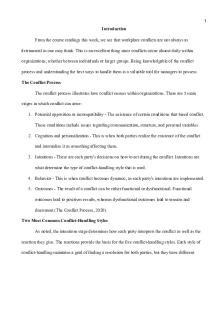BUS 5113 - Unit 5 Discussion PDF

| Title | BUS 5113 - Unit 5 Discussion |
|---|---|
| Author | Ashley Hitchcock |
| Course | Organizational Theory and Behavior |
| Institution | University of the People |
| Pages | 3 |
| File Size | 79.9 KB |
| File Type | |
| Total Downloads | 163 |
| Total Views | 328 |
Summary
1 Introduction From the course readings this week, we see that workplace conflicts are not always as detrimental as one may think. This is an excellent thing since conflicts occur almost daily within organizations, whether between individuals or larger groups. Being knowledgable of the conflict proc...
Description
1
Introduction From the course readings this week, we see that workplace conflicts are not always as detrimental as one may think. This is an excellent thing since conflicts occur almost daily within organizations, whether between individuals or larger groups. Being knowledgable of the conflict process and understanding the best ways to handle them is a valuable tool for managers to possess. The Conflict Process The conflict process illustrates how conflict ensues within organizations. There are 5 main stages in which conflict can arise: 1. Potential opposition or incompatibility - The existence of certain conditions that breed conflict. These conditions include issues regarding communication, structure, and personal variables. 2. Cognition and personalization - This is when both parties realize the existence of the conflict and internalize it as something affecting them. 3. Intentions - These are each party's decisions on how to act during the conflict. Intentions are what determine the type of conflict-handling style that is used. 4. Behavior - This is when conflict becomes dynamic, as each party's intentions are implemented. 5. Outcomes - The result of a conflict can be either functional or dysfunctional. Functional outcomes lead to positives results, whereas dysfunctional outcomes lead to tension and discontent (The Conflict Process, 2020). Two Most Common Conflict-Handling Styles As noted, the intentions stage determines how each party interprets the conflict as well as the reaction they give. The reactions provide the basis for the five conflict-handling styles. Each style of conflict-handling maintains a goal of finding a resolution for both parties, but they have different
2
methods of getting there. In addition, each style exhibits different levels of cooperativeness and assertiveness, and therefore each style has certain scenarios in which it is best suited. Two of the common conflict management styles are the compromising and collaborating styles. The compromising style has moderate concern for others and moderate concern for the goal. This style tries to find a middle ground between the two parties by making adjustments on both sides (Novak, 2019). Next, the collaborating style shows deep concern for others and a deep concern for the goal. Here, both parties put all ideas on the table and look for the best solution that they both agree will satisfy company goals. This style portrays a best-case scenario, but it can be hard to implement because it requires honest communication, and both parties must be able to openly express their concerns. (Novak, 2019) Recent Workplace Conflict For starters, my team is extremely close-knit, and for the most part, we are very open and straightforward with each other, especially if conflict begins to occur. That being said, the most recent conflict situation that I was involved in at work occurred during the opening of one of our new stores back in May. I work for a retail company, and we are continually opening new stores. When there is a rushed timeline to get a store fixtured and opened for a specific date, the corporate office sends me away for a couple of weeks to head up the merchandise lead role. As part of the new store process, it is my boss's job to develop a detailed merchandising plan and send it to me on the last day of fixturing to determine the product assortment for each aisle. He never followed up with the detailed plan, which left me scrambling during an already tight schedule. The conflict was resolved when I returned to the office, and we had a team meeting to discuss the issues. We discussed who is responsible for each part of the process and made sure that everyone will be held accountable for work.
3
References Novak, M. C. (2019). 5 Most Effective Conflict Management Styles. Retrieved from https://learn.g2.com/conflict-management-styles The Conflict Process | Organizational Behavior / Human Relations. (2020). Retrieved from
https://courses.lumenlearning.com/wm-organizationalbehavior/chapter/the-conflict-process/...
Similar Free PDFs

BUS 5113 - Unit 5 Discussion
- 3 Pages

BUS 5113 - Unit 6 Discussion
- 4 Pages

BUS 5113 Discussion Unit 7
- 3 Pages

Bus 1001 discussion unit 5
- 1 Pages

BUS 5113 Portfolio Unit 3 Answer
- 5 Pages

BUS 5113 Portfolio 2
- 3 Pages

Unit 2 - BUS 5115 Discussion
- 3 Pages

Discussion Unit 3 Bus 1103
- 2 Pages
Popular Institutions
- Tinajero National High School - Annex
- Politeknik Caltex Riau
- Yokohama City University
- SGT University
- University of Al-Qadisiyah
- Divine Word College of Vigan
- Techniek College Rotterdam
- Universidade de Santiago
- Universiti Teknologi MARA Cawangan Johor Kampus Pasir Gudang
- Poltekkes Kemenkes Yogyakarta
- Baguio City National High School
- Colegio san marcos
- preparatoria uno
- Centro de Bachillerato Tecnológico Industrial y de Servicios No. 107
- Dalian Maritime University
- Quang Trung Secondary School
- Colegio Tecnológico en Informática
- Corporación Regional de Educación Superior
- Grupo CEDVA
- Dar Al Uloom University
- Centro de Estudios Preuniversitarios de la Universidad Nacional de Ingeniería
- 上智大学
- Aakash International School, Nuna Majara
- San Felipe Neri Catholic School
- Kang Chiao International School - New Taipei City
- Misamis Occidental National High School
- Institución Educativa Escuela Normal Juan Ladrilleros
- Kolehiyo ng Pantukan
- Batanes State College
- Instituto Continental
- Sekolah Menengah Kejuruan Kesehatan Kaltara (Tarakan)
- Colegio de La Inmaculada Concepcion - Cebu







